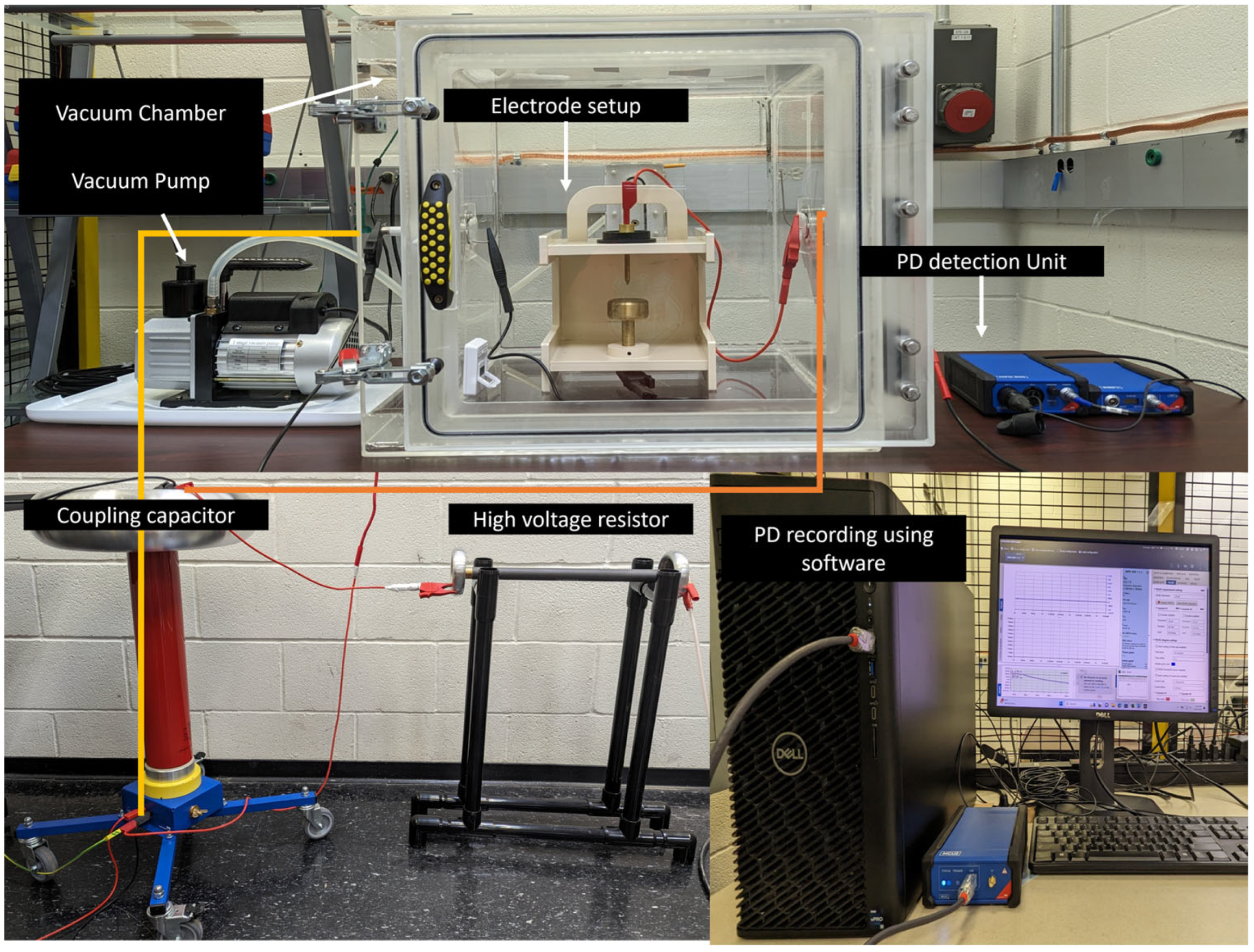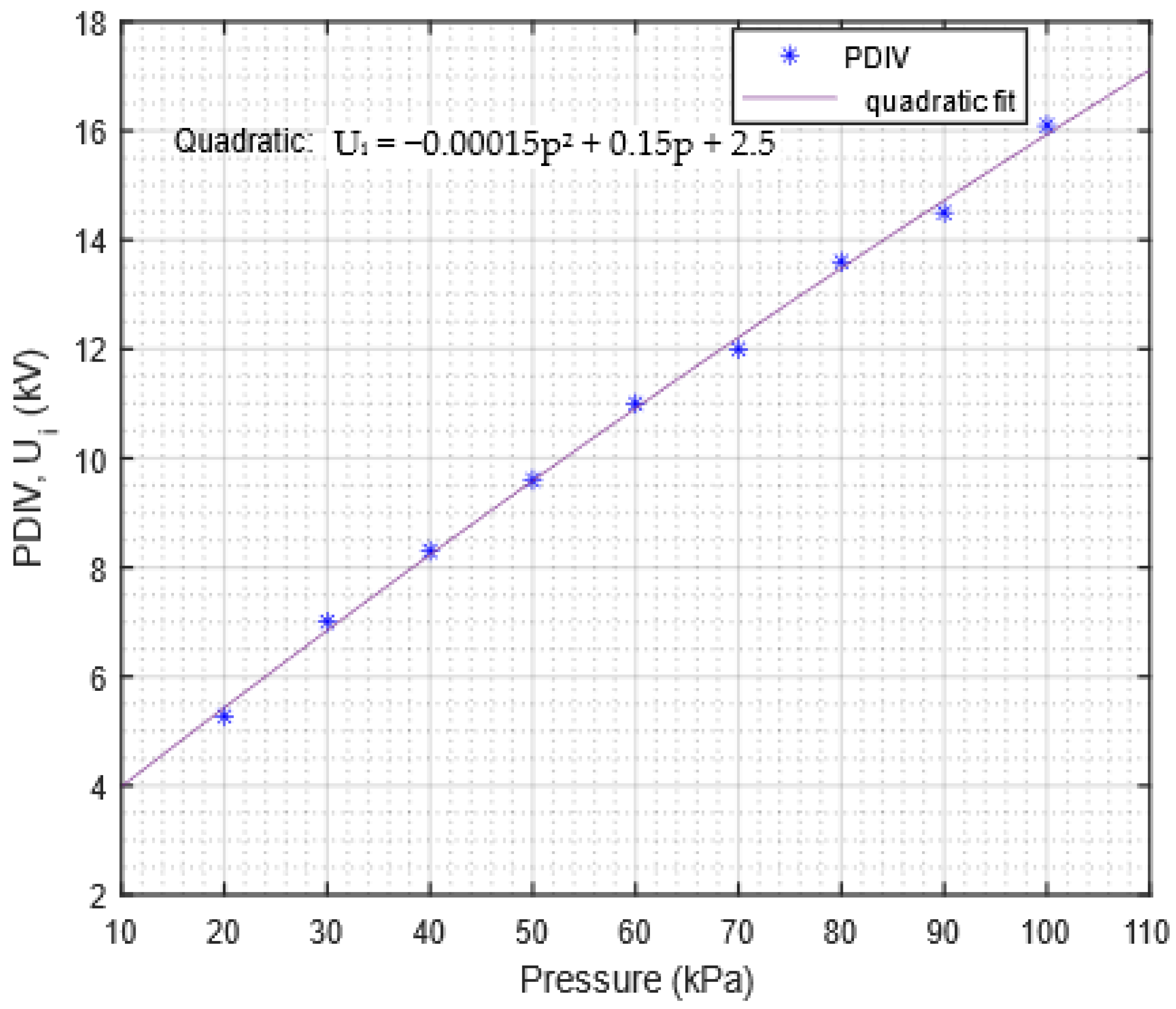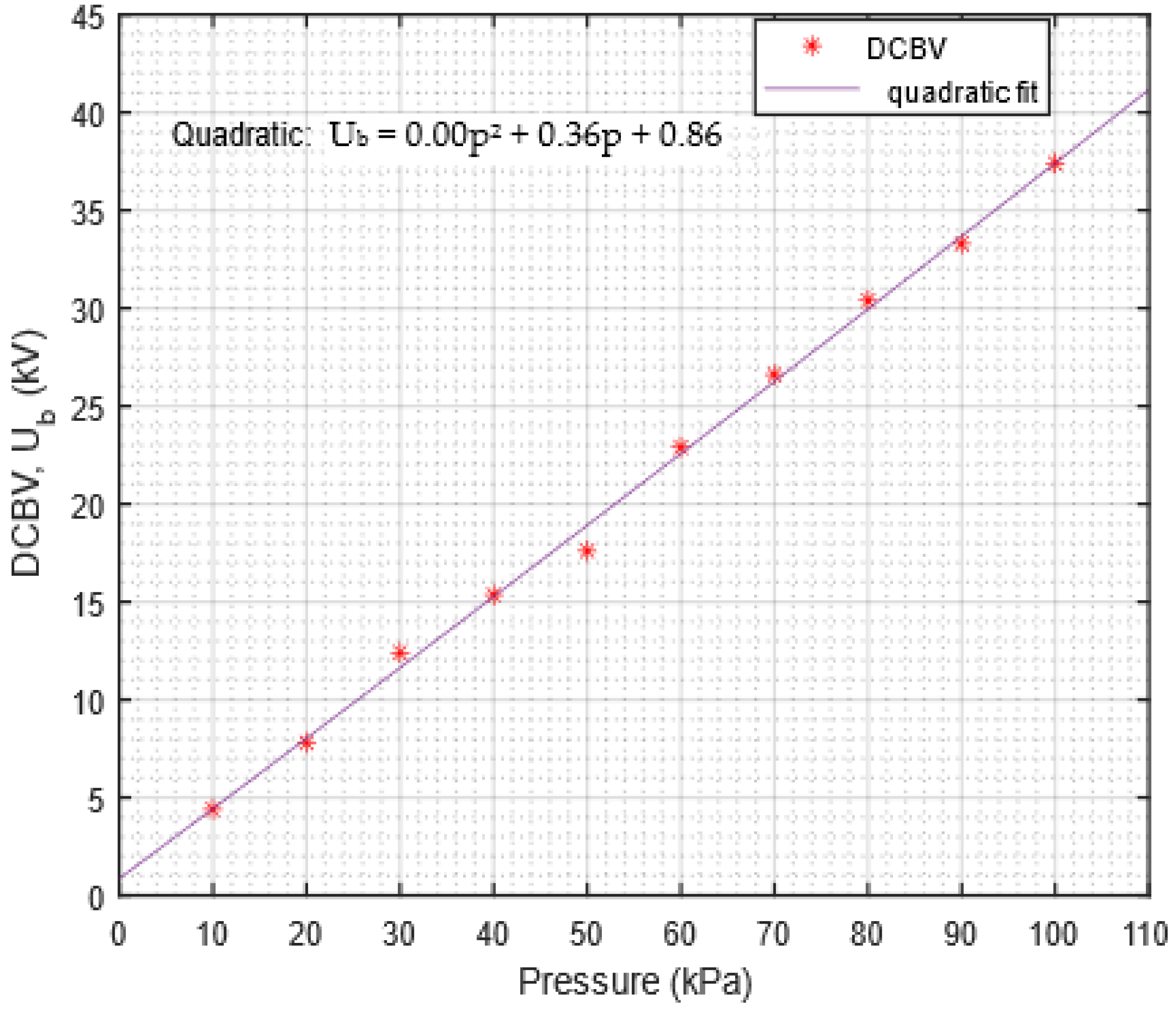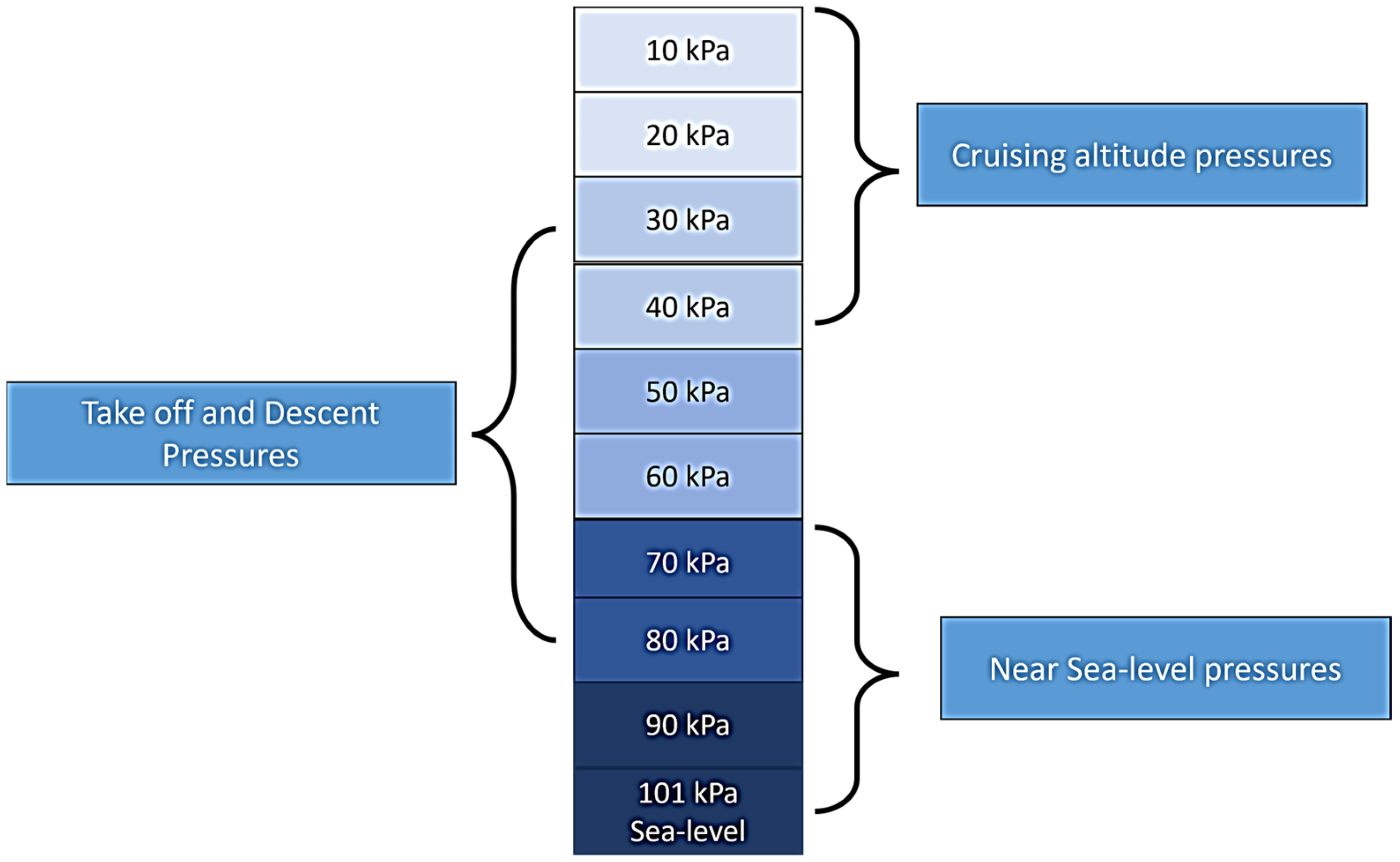Negative Medium-Voltage Direct Current Discharges in Air under Simulated Sub-Atmospheric Pressures for All-Electric Aircraft
Abstract
:1. Introduction
2. Materials and Methods
2.1. Materials
2.1.1. Simulation of Aviation Range Environment
2.1.2. Partial Discharge Measurement System
2.1.3. High Voltage Equipment
2.2. Method
- The PD detector was calibrated after a desired gap distance and pressure were set up inside the vacuum chamber.
- A constant voltage of 1 kV was applied to the circuit as the high voltage was turned on. After waiting for 10 s at this voltage, the applied voltage was increased at a rate of 100 V/s.
- The criterion for PDIV was the same as the one used by [12] for determining the PDIV. The voltage was said to be PDIV if the number of pulses reached at least 30 in one minute.
- There were many pulses before reaching the PDIV; however, the pulses were not recorded at each pulse. Only the pulses occurring close to the expected PDIV* were counted step after step, and PDIV was determined when the number of pulses in one minute exceeded 30.
- After the PDIV was recorded, voltage increments of 5% PDIV were applied until breakdown, and the data of the number of pulses and charge for each pulse were recorded for one minute at each step.
- The voltage was turned off after the gap between the electrodes was bridged (Figure 3) and the circuit was discharged using the discharge stick. The inlet valve was opened to release the pressure inside the vacuum chamber.
3. Results and Discussion
3.1. PDIV vs. Pressure
3.2. Breakdown Voltage vs. Pressure
3.3. ΔU vs. Pressure
3.4. Discussions
4. Conclusions
Author Contributions
Funding
Data Availability Statement
Conflicts of Interest
Appendix A
| Pressure (kPa) | Voltage Step (%PDIV) | Average Number of Pulses (N) | Average Charge per Pulse, Q (nC) | Total Charge in 1 min * (mC) |
|---|---|---|---|---|
| 20 | 1 | 564,335 | 1.54 | 0.869 |
| 1.05 | 925,296 | 1.55 | 1.434 | |
| 1.10 | 1,210,469 | 1.49 | 1.803 | |
| 1.15 | 1,632,795 | 1.4 | 2.285 | |
| 1.20 | 2,007,763 | 1.36 | 2.730 | |
| 1.25 | 2,314,652 | 1.30 | 3.009 | |
| 1.30 | 2,835,737 | 1.19 | 3.374 | |
| 1.35 | 3,413,823 | 1.09 | 3.721 | |
| 1.40 | 4,134,395 | 0.971 | 4.014 | |
| 1.45 | 5,318,406 | 0.825 | 4.387 | |
| 30 | 1 | 330 | 1.39 | ~0.000 |
| 1.05 | 288,668 | 1.20 | 0.346 | |
| 1.10 | 971,802 | 1.27 | 1.234 | |
| 1.15 | 1,332,117 | 1.17 | 1.558 | |
| 1.20 | 1,691,177 | 1.13 | 1.911 | |
| 1.25 | 1,980,400 | 1.08 | 2.138 | |
| 1.30 | 2,349,262 | 1.03 | 2.419 | |
| 1.35 | 2,691,508 | 0.98 | 2.637 | |
| 1.40 | 3,166,380 | 0.95 | 3.008 | |
| 1.45 | 3,587,033 | 0.89 | 3.192 | |
| 1.50 | 4,328,764 | 0.80 | 3.463 | |
| 1.55 | 5,000,209 | 0.71 | 3.550 | |
| 1.60 | 5,993,130 | 0.63 | 3.775 | |
| 1.65 | 7,388,522 | 0.59 | 4.359 | |
| 1.70 | 9,244,225 | 0.52 | 4.806 | |
| 1.75 | 11,058,569 | 0.47 | 5.197 | |
| 40 | 1 | 186 | 1.01 | ~0 |
| 1.05 | 11,246 | 1.22 | 0.013 | |
| 1.10 | 611,218 | 1.27 | 0.776 | |
| 1.15 | 865,702 | 1.23 | 1.064 | |
| 1.20 | 1,336,311 | 1.03 | 1.376 | |
| 1.25 | 1,585,851 | 1.03 | 1.633 | |
| 1.30 | 1,893,616 | 0.97 | 1.836 | |
| 1.35 | 2,228,637 | 0.93 | 2.072 | |
| 1.40 | 2,556,401 | 0.90 | 2.300 | |
| 1.45 | 2,914,971 | 0.87 | 2.536 | |
| 1.50 | 3,204,559 | 0.84 | 2.691 | |
| 1.55 | 3,669,939 | 0.79 | 2.899 | |
| 1.60 | 4,094,815 | 0.74 | 3.030 | |
| 1.65 | 4,756,863 | 0.66 | 3.139 | |
| 1.70 | 25,633 | 0.60 | 0.0153 | |
| 1.75 | 9 | 0.23 | ~0 | |
| 1.80 | 18 | 0.23 | ~0 | |
| 50 | 1 | 278 | 0.54 | ~0 |
| 1.05 | 25,638 | 1.33 | 0.034 | |
| 1.10 | 212,540 | 1.27 | 0.269 | |
| 1.15 | 905,183 | 1.24 | 1.122 | |
| 1.20 | 1,278,020 | 1.16 | 1.482 | |
| 1.25 | 1,649,766 | 0.95 | 1.567 | |
| 1.30 | 1,881,623 | 0.90 | 1.693 | |
| 1.35 | 2,123,688 | 0.87 | 1.847 | |
| 1.40 | 2,340,540 | 0.75 | 1.755 | |
| 1.45 | 3,055,066 | 0.66 | 2.016 | |
| 1.50 | 4,588,937 | 0.46 | 2.110 | |
| 1.55 | 4,534,546 | 0.49 | 2.221 | |
| 1.60 | 16 | 0.24 | ~0 | |
| 1.65 | 22 | 0.22 | ~0 | |
| 1.70 | 27 | 0.23 | ~0 | |
| 1.75 | 29 | 0.24 | ~0 | |
| 1.80 | 42 | 0.23 | ~0 | |
| 60 | 1 | 312 | 0.09 | ~0 |
| 1.05 | 14,840 | 0.46 | 0.006 | |
| 1.10 | 500,445 | 0.432 | 0.216 | |
| 1.15 | 579,861 | 0.50 | 0.289 | |
| 1.20 | 791,113 | 0.50 | 0.395 | |
| 1.25 | 1,237,954 | 0.432 | 0.534 | |
| 1.30 | 1,689,084 | 0.356 | 0.601 | |
| 1.35 | 2,008,412 | 0.317 | 0.636 | |
| 1.40 | 2,400,942 | 0.294 | 0.705 | |
| 1.45 | 2,657,159 | 0.278 | 0.738 | |
| 1.50 | 2,878,260 | 0.269 | 0.774 | |
| 1.55 | 3,129,325 | 0.258 | 0.807 | |
| 1.60 | 3,485,941 | 0.246 | 0.857 | |
| 1.65 | 4,310,657 | 0.200 | 0.862 | |
| 1.70 | 5,370,718 | 0.167 | 0.896 | |
| 1.75 | 1 | 0.08 | ~0 | |
| 1.80 | 22 | 0.103 | ~0 | |
| 1.85 | 6560 | 0.195 | 0.001 | |
| 1.90 | 8031 | 0.08 | 0.000 | |
| 1.95 | 14,441 | 0.077 | 0.001 | |
| 2.00 | 21,429 | 0.075 | 0.001 | |
| 2.05 | 29,045 | 0.074 | 0.002 | |
| 70 | 1 | 30 | 0.622 | 0 |
| 1.05 | 6496 | 0.988 | 0.006 | |
| 1.10 | 61,656 | 1.11 | 0.068 | |
| 1.15 | 126,309 | 1.15 | 0.145 | |
| 1.20 | 221,023 | 1.14 | 0.251 | |
| 1.25 | 1,075,393 | 0.988 | 1.062 | |
| 1.30 | 1,386,723 | 0.929 | 1.288 | |
| 1.35 | 1,795,340 | 0.782 | 1.403 | |
| 1.40 | 2,156,008 | 0.669 | 1.442 | |
| 1.45 | 2,418,509 | 0.622 | 1.504 | |
| 1.50 | 2,627,285 | 0.603 | 1.584 | |
| 1.55 | 2,852,660 | 0.585 | 1.668 | |
| 1.60 | 3,027,824 | 0.563 | 1.704 | |
| 1.65 | 3,422,339 | 0.521 | 1.783 | |
| 1.70 | 4,171,817 | 0.414 | 1.727 | |
| 1.75 | 0 | 0 | 0 | |
| 1.80 | 0 | 0 | 0 | |
| 1.85 | 0 | 0 | 0 | |
| 1.90 | 103 | 0.551 | ~0 | |
| 1.95 | 1207 | 0.650 | ~0 | |
| 2.00 | 7063 | 0.328 | 0.002 | |
| 2.05 | 22,970 | 0.168 | 0.003 | |
| 2.10 | 35,367 | 0.165 | 0.005 | |
| 2.15 | 47,155 | 0.162 | 0.007 | |
| 2.20 | 57,888 | 0.158 | 0.009 | |
| 80 | 1 | 32 | 0.56 | ~0 |
| 1.05 | 5601 | 0.93 | 0.005 | |
| 1.10 | 49,107 | 0.975 | 0.047 | |
| 1.15 | 154,240 | 1.09 | 0.168 | |
| 1.20 | 549,821 | 0.68 | 0.373 | |
| 1.25 | 997,387 | 0.948 | 0.945 | |
| 1.30 | 1,389,527 | 0.908 | 1.261 | |
| 1.35 | 1,794,853 | 0.803 | 1.441 | |
| 1.40 | 2,274,760 | 0.659 | 1.499 | |
| 1.45 | 2,580,379 | 0.604 | 1.558 | |
| 1.50 | 2,787,212 | 0.578 | 1.611 | |
| 1.55 | 3,063,325 | 0.550 | 1.684 | |
| 1.60 | 3,399,367 | 0.509 | 1.730 | |
| 1.65 | 3,930,691 | 0.467 | 1.835 | |
| 1.70 | 4,180,136 | 0.424 | 1.772 | |
| 1.75 | 1969 | 0.492 | 0.000 | |
| 1.80 | 10,924 | 0.362 | 0.003 | |
| 1.85 | 14,114 | 0.151 | 0.002 | |
| 1.90 | 22,568 | 0.149 | 0.003 | |
| 1.95 | 33,067 | 0.147 | 0.004 | |
| 2.00 | 40,890 | 0.146 | 0.005 | |
| 2.05 | 52,263 | 0.145 | 0.007 | |
| 2.10 | 62,972 | 0.142 | 0.008 | |
| 2.15 | 75,012 | 0.140 | 0.010 | |
| 2.20 | 90,284 | 0.137 | 0.012 | |
| 90 | 1 | 80 | 0.067 | ~0 |
| 1.05 | 45,411 | 0.087 | 0.003 | |
| 1.10 | 160,628 | 0.105 | 0.016 | |
| 1.15 | 364,079 | 0.112 | 0.040 | |
| 1.20 | 923,833 | 0.052 | 0.048 | |
| 1.25 | 1,309,125 | 0.041 | 0.053 | |
| 1.30 | 1,381,399 | 0.053 | 0.073 | |
| 1.35 | 1,662,093 | 0.0465 | 0.077 | |
| 1.40 | 1,907,103 | 0.0415 | 0.079 | |
| 1.45 | 2,488,556 | 0.0622 | 0.154 | |
| 1.50 | 2,810,046 | 0.0567 | 0.159 | |
| 1.55 | 3,160,382 | 0.0533 | 0.168 | |
| 1.60 | 3,709,401 | 0.0488 | 0.181 | |
| 1.65 | 3,921,124 | 0.0457 | 0.179 | |
| 1.70 | 4,281,277 | 0.0432 | 0.184 | |
| 1.75 | 4,653,566 | 0.0402 | 0.187 | |
| 1.80 | 386,280 | 0.038 | 0.014 | |
| 1.85 | 7447 | 0.041 | ~0 | |
| 1.90 | 14,250 | 0.0159 | ~0 | |
| 1.95 | 21,005 | 0.0158 | ~0 | |
| 2.00 | 28,825 | 0.0157 | ~0 | |
| 2.05 | 38,857 | 0.0155 | ~0 | |
| 2.10 | 45,349 | 0.0153 | ~0 | |
| 2.15 | 30,932 | 0.0151 | ~0 | |
| 2.20 | 143 | 0.0155 | ~0 | |
| 2.25 | 25 | 0.0169 | ~0 | |
| 101 | 1.00 | 43 | 0.424 | ~0 |
| 1.05 | 15,063 | 0.632 | ~0 | |
| 1.10 | 352,123 | 0.615 | 0.216 | |
| 1.15 | 247,762 | 0.877 | 0.217 | |
| 1.20 | 1,973,314 | 0.211 | 0.416 | |
| 1.25 | 2,013,753 | 0.346 | 0.696 | |
| 1.30 | 7,528,563 | 0.0486 | 0.365 | |
| 1.35 | 6,679,225 | 0.103 | 0.687 | |
| 1.40 | 4,987,375 | 0.233 | 1.162 | |
| 1.45 | 3,977,923 | 0.341 | 1.356 | |
| 1.50 | 3,334,084 | 0.436 | 1.453 | |
| 1.55 | 3,369,354 | 0.440 | 1.482 | |
| 1.60 | 3,946,007 | 0.395 | 1.558 | |
| 1.65 | 4,465,641 | 0.365 | 1.629 | |
| 1.70 | 5,016,748 | 0.341 | 1.710 | |
| 1.75 | 5,458,860 | 0.311 | 1.697 | |
| 1.80 | 5,708,230 | 0.292 | 1.666 | |
| 1.85 | 96,171 | 0.00516 | 0.000 | |
| 1.90 | 13,999 | 0.106 | 0.001 | |
| 1.95 | 21,790 | 0.106 | 0.002 | |
| 2.00 | 31,000 | 0.106 | 0.003 | |
| 2.05 | 41,515 | 0.106 | 0.004 | |
| 2.10 | 450,916 | 0.106 | 0.047 | |
| 2.15 | 61,119 | 0.104 | 0.006 | |
| 2.20 | 76,568 | 0.103 | 0.007 | |
| 2.25 | 93,725 | 0.102 | 0.009 | |
| 2.30 | 110,619 | 0.0997 | 0.011 |
References
- IEA. Aviation. Available online: https://www.iea.org/energy-system/transport/aviation (accessed on 4 March 2024).
- Wheeler, P.; Bozhko, S. The More Electric Aircraft: Technology and challenges. IEEE Electrific. Mag. 2014, 2, 6–12. [Google Scholar] [CrossRef]
- Jones, R.I. The More Electric Aircraft: The past and the future? In Proceedings of the IEE Colloquium on Electrical Machines and Systems for the More Electric Aircraft, London, UK, 9 November 1999. [Google Scholar]
- Saha, A.; Azizi, A.; Ghassemi, M. Optimal Bipolar MVDC Power Cable Designs for Future Wide-Body All Electric Aircraft. IEEE Trans. Dielectr. Electr. Insul. 2024. [Google Scholar] [CrossRef]
- Saha, A.; Ghassemi, M. Optimized Design of ±5 kV, 1 kA Rectangular Power Cable for a Low Pressure of 18.8 kPa for Envisioned All-Electric Wide-Body Aircraft. IEEE Access 2024, 12, 28654–28665. [Google Scholar] [CrossRef]
- Sumsurooah, S.; He, Y.; Torchio, M.; Kouramas, K.; Guida, B.; Cuomo, F.; Atkin, J.; Bozhko, S.; Renzetti, A.; Russo, A.; et al. ENIGMA—A Centralised Supervisory Controller for Enhanced Onboard Electrical Energy Management with Model in the Loop Demonstration. Energies 2021, 14, 5518. [Google Scholar] [CrossRef]
- Russo, A.; Guida, B.; Canciello, G.; Cavallo, A. 13—Energy system management for aeronautic and aerospace applications: Demonstration and study cases, Hybrid Technologies for Power Generation. In Hybrid Energy Systems; Faro, M.L., Barbera, O., Giacoppo, G., Eds.; Academic Press: New York, NY, USA, 2022; pp. 373–418. [Google Scholar]
- Air—Density and Specific Volume, vs. Altitude. Available online: https://www.engineeringtoolbox.com/air-altitude-density-volume-d_195.html (accessed on 4 March 2024).
- Borghei, M.; Ghassemi, M. Insulation Materials and Systems for More- and All-Electric Aircraft: A Review Identifying Challenges and Future Research Needs. IEEE Trans. Transp. Electrif. 2021, 7, 1930–1953. [Google Scholar] [CrossRef]
- Arora, R.; Mosch, W. Field Dependent behavior of Air and Other Gaseous Dielectrics. In High Voltage and Electrical Insulation Engineering; John Wiley & Sons, Ltd.: New York, NY, USA, 2011. [Google Scholar]
- Driessen, A.B.J.M.; van Duivenbode, J.; Wouters, P.A.A.F. Partial discharge detection for characterizing cable insulation under low and medium vacuum conditions. IEEE Trans. Dielectr. Electr. Insul. 2018, 25, 306–315. [Google Scholar] [CrossRef]
- Jiang, J.; Zhang, B.; Li, Z.; Zhang, C.; Ranjan, P.; Zhang, X. Partial Discharge Investigation under Low Air Pressure and Variable Frequency for More-Electric-Aircraft. IEEE Trans. Dielectr. Electr. Insul. 2021, 28, 1793–1801. [Google Scholar] [CrossRef]
- Götz, T.; Kosse, M.; Riechert, U.; Abbasi, A.; Castellon, J.; Cavallini, A.; Esterl, F.; Geissler, M.; Hochbrückner, B. Interim Report of WG D1.63: Progress on Partial discharge detection under DC voltage stress. In Proceedings of the International Colloquium on Power Transformers & Reactors, Overhead Lines; and Materials and Emerging Test Techniques (Under the Aegis of CIGRE SC A2 on Transformers; B2 on Overhead Lines and D1 on Materials), New Delhi, India, 21–22 November 2019. [Google Scholar]
- Florkowski, M.; Florkowska, B.; Zydron, P. Partial discharge forms for DC insulating systems at higher air pressure. IET Sci. Meas. Amp Technol. 2016, 10, 150–157. [Google Scholar] [CrossRef]
- Hamidieh, M.; Kalakonda, S.P.; Ghassemi, M. Influence of Aircraft-Environment Pressure Range on Negative DC Partial Discharge Inception Voltage. In Proceedings of the IEEE Texas Power and Energy Conference (TPEC), College Station, TX, USA, 2 December 2024; pp. 1–6. [Google Scholar]
- Hamidieh, M.; Ghassemi, M. Conic Cross-Sectional Electrodes and Their Influence on Negative Corona Discharge and Trichel Pulse Characteristics. IEEE Trans. Dielectr. Electr. Insul. 2024. [Google Scholar] [CrossRef]








| Pressure (kPa) | Ui (kV), PDIV | Ub (kV), Breakdown Voltage | ΔU = Ub − Ui (kV) |
|---|---|---|---|
| 10 | – | 4.4 | – |
| 20 | 5.27 | 7.8 | 2.53 |
| 30 | 7 | 12.4 | 5.4 |
| 40 | 8.3 | 15.35 | 7.05 |
| 50 | 9.6 | 17.6 | 8 |
| 60 | 11 | 22.9 | 11.9 |
| 70 | 12 | 26.6 | 14.6 |
| 80 | 13.6 | 30.4 | 16.8 |
| 90 | 14.5 | 33.3 | 18.8 |
| 101 | 16.1 | 37.4 | 21.3 |
Disclaimer/Publisher’s Note: The statements, opinions and data contained in all publications are solely those of the individual author(s) and contributor(s) and not of MDPI and/or the editor(s). MDPI and/or the editor(s) disclaim responsibility for any injury to people or property resulting from any ideas, methods, instructions or products referred to in the content. |
© 2024 by the authors. Licensee MDPI, Basel, Switzerland. This article is an open access article distributed under the terms and conditions of the Creative Commons Attribution (CC BY) license (https://creativecommons.org/licenses/by/4.0/).
Share and Cite
Kalakonda, S.P.; Hamidieh, M.; Bhojwani, A.; Ghassemi, M. Negative Medium-Voltage Direct Current Discharges in Air under Simulated Sub-Atmospheric Pressures for All-Electric Aircraft. Aerospace 2024, 11, 444. https://doi.org/10.3390/aerospace11060444
Kalakonda SP, Hamidieh M, Bhojwani A, Ghassemi M. Negative Medium-Voltage Direct Current Discharges in Air under Simulated Sub-Atmospheric Pressures for All-Electric Aircraft. Aerospace. 2024; 11(6):444. https://doi.org/10.3390/aerospace11060444
Chicago/Turabian StyleKalakonda, Sai Pavan, Mohammad Hamidieh, Adil Bhojwani, and Mona Ghassemi. 2024. "Negative Medium-Voltage Direct Current Discharges in Air under Simulated Sub-Atmospheric Pressures for All-Electric Aircraft" Aerospace 11, no. 6: 444. https://doi.org/10.3390/aerospace11060444






